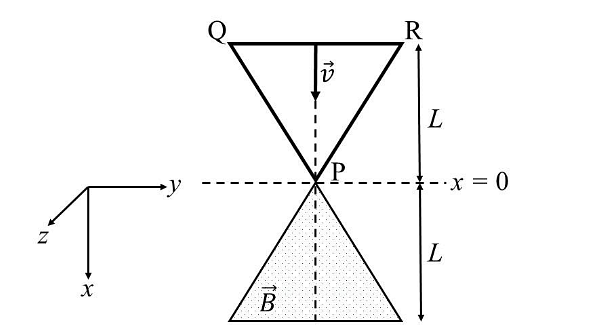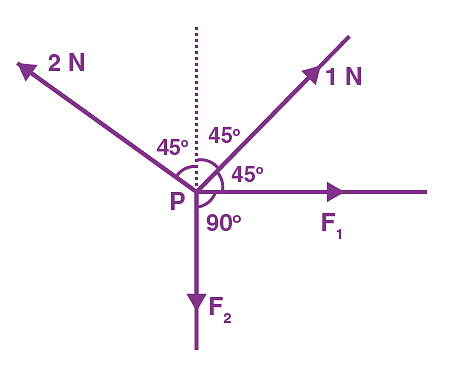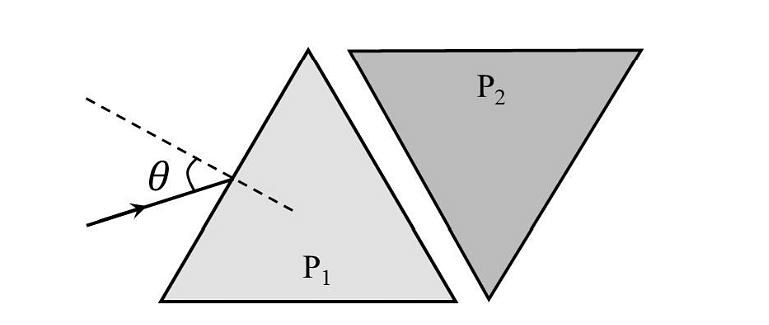Question:
Two thin circular discs of mass $m$ and $4\, m$, having radii of $a$ and $2 a$, respectively, are rigidly fixed by a massless, rigid rod of length $l=\sqrt{24}$ a through their centers. This assembly is laid on a firm and flat surface and set rolling without slipping on the surface so that the angular speed about the axis of the rod is $\omega$. The angular momentum of the entire assembly about the point 'O' is $\vec{ L }$ (see the figure). Which of the following statement(s) is(are) true?
Two thin circular discs of mass $m$ and $4\, m$, having radii of $a$ and $2 a$, respectively, are rigidly fixed by a massless, rigid rod of length $l=\sqrt{24}$ a through their centers. This assembly is laid on a firm and flat surface and set rolling without slipping on the surface so that the angular speed about the axis of the rod is $\omega$. The angular momentum of the entire assembly about the point 'O' is $\vec{ L }$ (see the figure). Which of the following statement(s) is(are) true?
Updated On: Jan 18, 2023
- The magnitude of the z-component of $\vec{L}$ is $55\, ma ^{2} \omega$
- The magnitude of angular momentum of center of mass of the assembly about the point $O$ is $81\, ma ^{2} \omega$
- The center of mass the assembly rotates about the z-axis with an angular speed of $\omega / 5$
- The magnitude of angular momentum of the assembly about its center of mass is $17\, ma ^{2} \omega / 2$
Hide Solution
Verified By Collegedunia
The Correct Option is D
Solution and Explanation
Top view
$\omega_{1}=\frac{ a \omega}{\ell} \Rightarrow v _{ cm }=\omega_{1}\left(\ell+\frac{4 \ell}{5}\right)$
$v _{ cm }=\frac{ a \omega}{\ell}\left(\frac{9 \ell}{5}\right)$
$v _{ cm }=\frac{9 a \omega}{5}$
angular momentum of COM about point of
$=\vec{r}_{c m} \times\left(m_{T} \vec{v}_{c m}\right)$
$= r _{ cm } m _{ T } v _{ cm}$
$=\frac{9 \ell}{5} \times(5 m )\left(\frac{9 a \omega}{5}\right)$
$=\frac{81}{5} a\ell m \omega$
$=\frac{81}{5} \times a \sqrt{24} a \times m \omega$
$=\frac{81}{5} \times \sqrt{24} a ^{2} m \omega$
Angular velocity of COM about $z$ axis
$\omega_{1}=\frac{ a \omega}{\ell}=\frac{ a \omega}{\sqrt{24} a }=\frac{\omega}{\sqrt{24}}$
$\omega_{z}=\omega_{1} \cos \theta$
$\omega_{z}=\frac{\omega}{\sqrt{24}} \times\left(\frac{\ell}{\sqrt{\ell^{2}+ a ^{2}}}\right)$
$=\frac{\omega \ell}{\sqrt{24} \times\left(\sqrt{25 a ^{2}}\right)}$
$\Rightarrow \frac{\omega \sqrt{24} a }{\sqrt{24} \cdot 5 a }=\frac{\omega}{5}$
Angular momentum about. $COM = I _{ cm } \omega$
$=\left(\frac{m a^{2}}{2}+\frac{4 m(2 a)^{2}}{2}\right) \omega$
$\Rightarrow\left(\frac{m a^{2}}{2}+8 m a^{2}\right) \omega$
$L _{ wrt\,cm }=\frac{17\, ma ^{2}}{2} \omega$
angular momentum about $O$ has component along $z$-axis
$=L_{cm} \cos \theta-L_{wrt\, cm} \sin \theta$
$=\frac{81}{5} \sqrt{24} m \omega a^{2} \cos \theta-\frac{17 ma ^{2}}{2} \omega \sin \theta$
$=\frac{81}{5} \sqrt{24}\left(\frac{\ell}{\sqrt{\ell^{2}+a^{2}}}\right) m \omega a^{2}-\frac{17 m a^{2}}{2} \omega\left[\frac{a}{\sqrt{\ell^{2}+a^{2}}}\right]$
$\Rightarrow \frac{81 \times 24}{25} m \omega a^{2}-\frac{17}{10} m a^{2} \omega$
$\Rightarrow\left(\frac{81 \times 24 \times 2-17 \times 5}{50}\right) m \omega a^{2}$
$\omega_{1}=\frac{ a \omega}{\ell} \Rightarrow v _{ cm }=\omega_{1}\left(\ell+\frac{4 \ell}{5}\right)$
$v _{ cm }=\frac{ a \omega}{\ell}\left(\frac{9 \ell}{5}\right)$
$v _{ cm }=\frac{9 a \omega}{5}$
angular momentum of COM about point of
$=\vec{r}_{c m} \times\left(m_{T} \vec{v}_{c m}\right)$
$= r _{ cm } m _{ T } v _{ cm}$
$=\frac{9 \ell}{5} \times(5 m )\left(\frac{9 a \omega}{5}\right)$
$=\frac{81}{5} a\ell m \omega$
$=\frac{81}{5} \times a \sqrt{24} a \times m \omega$
$=\frac{81}{5} \times \sqrt{24} a ^{2} m \omega$
Angular velocity of COM about $z$ axis
$\omega_{1}=\frac{ a \omega}{\ell}=\frac{ a \omega}{\sqrt{24} a }=\frac{\omega}{\sqrt{24}}$
$\omega_{z}=\omega_{1} \cos \theta$
$\omega_{z}=\frac{\omega}{\sqrt{24}} \times\left(\frac{\ell}{\sqrt{\ell^{2}+ a ^{2}}}\right)$
$=\frac{\omega \ell}{\sqrt{24} \times\left(\sqrt{25 a ^{2}}\right)}$
$\Rightarrow \frac{\omega \sqrt{24} a }{\sqrt{24} \cdot 5 a }=\frac{\omega}{5}$
Angular momentum about. $COM = I _{ cm } \omega$
$=\left(\frac{m a^{2}}{2}+\frac{4 m(2 a)^{2}}{2}\right) \omega$
$\Rightarrow\left(\frac{m a^{2}}{2}+8 m a^{2}\right) \omega$
$L _{ wrt\,cm }=\frac{17\, ma ^{2}}{2} \omega$
angular momentum about $O$ has component along $z$-axis
$=L_{cm} \cos \theta-L_{wrt\, cm} \sin \theta$
$=\frac{81}{5} \sqrt{24} m \omega a^{2} \cos \theta-\frac{17 ma ^{2}}{2} \omega \sin \theta$
$=\frac{81}{5} \sqrt{24}\left(\frac{\ell}{\sqrt{\ell^{2}+a^{2}}}\right) m \omega a^{2}-\frac{17 m a^{2}}{2} \omega\left[\frac{a}{\sqrt{\ell^{2}+a^{2}}}\right]$
$\Rightarrow \frac{81 \times 24}{25} m \omega a^{2}-\frac{17}{10} m a^{2} \omega$
$\Rightarrow\left(\frac{81 \times 24 \times 2-17 \times 5}{50}\right) m \omega a^{2}$
Was this answer helpful?
0
0
Top Questions on torque
- A region in the form of an equilateral triangle (in x-y plane) of height L has a uniform magnetic field 𝐵⃗ pointing in the +z-direction. A conducting loop PQR, in the form of an equilateral triangle of the same height 𝐿, is placed in the x-y plane with its vertex P at x = 0 in the orientation shown in the figure. At 𝑡 = 0, the loop starts entering the region of the magnetic field with a uniform velocity 𝑣 along the +x-direction. The plane of the loop and its orientation remain unchanged throughout its motion.

Which of the following graph best depicts the variation of the induced emf (E) in the loop as a function of the distance (𝑥) starting from 𝑥 = 0? - The number of turns of the coil of a moving coil galvanometer is increased in order to increase current sensitivity by $50 \%$ The percentage change in voltage sensitivity of the galvanometer will be:
- The torque acting on a magnetic dipole placed in uniform magnetic field is zero, when the angle between the dipole axis and the magnetic field is _____.
- A metre scale is balanced on a knife edge at its centre. When two coins, each of mass 10 g are put one on the top of the other at the 10.0 cm mark the scale is found to be balanced at the 40.0 cm mark. The mass of the metre scale is found to be \(x\times 10^{-2}\) kg. The value of x is _________.
- For forces are acting at a point P in equilibrium as shown in the figure. The ratio of force F1 to F2 is 1 : x where x =___.

View More Questions
Questions Asked in JEE Advanced exam
- Let \(S=\left\{\begin{pmatrix} 0 & 1 & c \\ 1 & a & d\\ 1 & b & e \end{pmatrix}:a,b,c,d,e\in\left\{0,1\right\}\ \text{and} |A|\in \left\{-1,1\right\}\right\}\), where |A| denotes the determinant of A. Then the number of elements in S is _______.
- JEE Advanced - 2024
- Matrices
- A block of mass \(5 kg\) moves along the \(x-\)direction subject to the force \(F = (−20x + 10) N,\) with the value of \(x \) in metre. At time \(t = 0 s,\) it is at rest at position \(x = 1 m\). The position and momentum of the block at \(t = (\pi/4)\) s are
- JEE Advanced - 2024
- Work-energy theorem
- Two equilateral-triangular prisms \(P_1 \)and \(P_2\) are kept with their sides parallel to each other, in vacuum, as shown in the figure. A light ray enters prism \(P_1\) at an angle of incidence 𝜃 such that the outgoing ray undergoes minimum deviation in prism \(P_2\). If the respective refractive indices of \(P_1\) and\( P_2\) are \(√ 3 /2\) and \(√3\), then \(\theta = sin{−1}[\sqrt \frac{ 3}{ 2} sin ( \frac{\pi}{B} )],\) where the value of \(\beta\) is ______.

- JEE Advanced - 2024
- Ray optics and optical instruments
- Let \(\overrightarrow{OP}=\frac{\alpha-1}{\alpha}\hat{i}+\hat{j}+\hat{k},\overrightarrow{OQ}=\hat{i}+\frac{\beta-1}{\beta}\hat{j}+\hat{k}\) and \(\overrightarrow{OR}=\hat{i}+\hat{j}+\frac{1}{2}\hat{k}\) be three vector where α, β ∈ R - {0} and 0 denotes the origin. If \((\overrightarrow{OP}\times\overrightarrow{OQ}).\overrightarrow{OR}=0\) and the point (α, β, 2) lies on the plane 3x + 3y - z + l = 0, then the value of l is _______.
- JEE Advanced - 2024
- Vector Algebra
- Let \(\vec{p}=2\hat{i}+\hat{j}+3\hat{k}\) and \(\vec{q}=\hat{i}-\hat{j}+\hat{k}\). If for some real numbers α, β and γ we have
\(15\hat{i}+10\hat{j}+6\hat{k}=α(2\vec{p}+\vec{q})+β(\vec{p}-2\vec{q})+γ(\vec{p}\times\vec{q})\),
then the value of γ is ________.- JEE Advanced - 2024
- Vector Algebra
View More Questions
Concepts Used:
Torque
Torque is a moment of force. Torque is measured as a force that causeque is also defined as the turning effect of force on the axis of rotation. Torque is chs an object to rotate about an axis and is responsible for the angular acceleration. Characterized with “T”.
How is Torque Calculated?
Torque is calculated as the magnitude of the torque vector T for a torque produced by a given force F
T = F. Sin (θ)
Where,
r - length of the moment arm,
θ - the angle between the force vector and the moment arm.
Read More: Torque
Types of Torque
Torque is of two types:
- Static torque
- Dynamic torque



